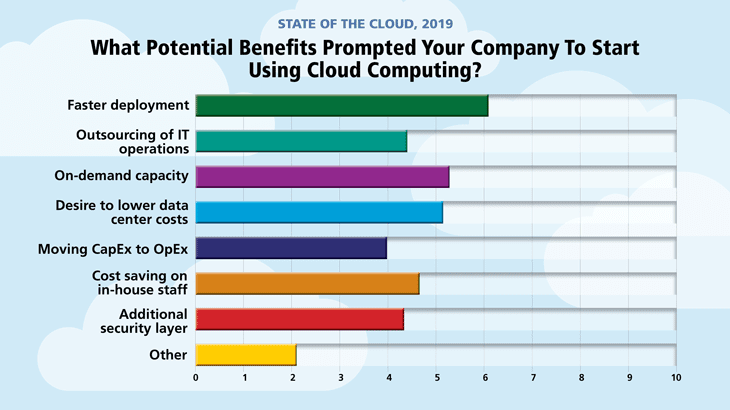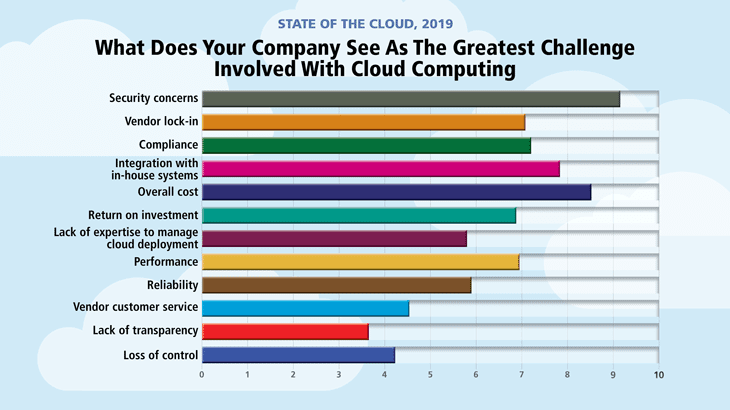
Now in 2019, enterprise adoption of cloud computing has gone far beyond the exploratory phase. The use of cloud is seen as mission critical rather than strategic. Businesses use services from IaaS to higher order platforms like PaaS, containers and serverless to deploy their applications in production.
Now that cloud is more established than merely emerging, what do businesses see as the benefits and challenges? In other words, how are current cloud deployments living up to the earlier hype about the wonders of cloud?
Protecting your company’s data is critical. Cloud storage with automated backup is scalable, flexible and provides peace of mind. Cobalt Iron’s enterprise-grade backup and recovery solution is known for its hands-free automation and reliability, at a lower cost. Cloud backup that just works.
To explore this, Datamation offered an in-depth and wide ranging survey about how businesses feel about their cloud platforms, State of the Cloud, 2019. Let’s look at some of the results.
Also see: Top Cloud Computing Companies

(Note: respondents rated each option on a scale of 1-4; the answers were combined into an overall scale from 1-10.)
As you’ll see above, there are an entire handful of potential benefits that businesses seek in the cloud. If you look inside these responses, you’ll see three key benefits.
Clearly, agility is one of the biggest benefits of cloud computing. The survey responses indicate this by listing faster deployment as the top choice for migrating to the cloud.
Cloud helps organizations take their product to market faster by streamlining the deployment process. The self-service capabilities, auto scaling and programmatic interfaces reduce the deployment times and make organizations far more agile.
The high rank for the answer “on-demand capacity” also reflects this. Again, organizations are embracing cloud due to the agility it offers in deploying applications. The enterprise’s digital transformation is about being nimble and delivering business value more frequently. This agile innovation is clearly aided by public cloud computing and will likely continue to be a key driver for cloud adoption.
The high cost of maintaining data centers and the expense of IT operations play a critical role in the shift towards cloud computing. The Datamation survey points out to this advantage: organizations see value in having on-demand capacity without having to build up excess capacity for future needs.
Furthermore, there are cost savings associated with cloud’s pay-per-use model. This includes the advantage of needing less in-house staff to maintain the infrastructure, and outsourcing the IT operations. Along with the above mentioned cost advantages, cloud computing also shifts from a Capex model to an Opex model – as noted in the survey – which offers more financial flexibility for organizations.
In the early days of cloud computing, people were always concerned about cloud security. However, this fear turned out to be a misunderstanding. In fact, cloud providers are more prepared to provide better security than most organizations.
Cloud companies can not only hire the top security experts, they have a lot more data to use for machine learning, to proactively stop security threats. So it’s no surprise that the survey showed a significant number of respondents highlighting security as a reason for moving to cloud.
And yet, as we see below, businesses have mixed attitudes toward cloud security.

(Note: respondents rated each option on a scale of 1-4; the answers were combined into an overall scale from 1-10.)
As the Datamation survey reveals, businesses know that cloud computing is no magic pill. There are many challenges that organizations face as they migrate their apps to cloud. Let’s look at some of the most compelling challenges faced by cloud users.
In spite of the fact that cloud providers can offer better security than most in-house teams, the survey respondents have highlighted security as one of the major challenges. The reasons for this are numerous.
Vendor lock-in risk, a key concern among survey respondents, is always a challenge. It is important for organizations to have a clear strategy on mitigating this risk. Use of containers and multicloud could help mitigate some of the challenges.
Even though cloud offers many cost advantages, it can be expensive for organizations at a certain scale. Or, costs can grow if companies are using cloud-based AI or Big Data.
Another concern is the lack of transparency on the side of cloud providers. In the case of a security breach, the customers will not know about it for an unspecified time. This is unacceptable for many organizations.
In short, based on the Datamation survey, we can conclude that organizations see significant value in the cloud even though they have concerns about security, cost, and compliance. We recommend that organizations spend their time understanding various cloud services from different cloud companies before they advance further on their cloud journey.
Survey methodology: Conducted in April, 2019, the Datamation survey was taken by 108 qualified technology professionals from a wide spectrum of industries, including financial services, retail, technology and healthcare.
SEE ALL
Datamation is the leading industry resource for B2B data professionals and technology buyers. Datamation's focus is on providing insight into the latest trends and innovation in AI, data security, big data, and more, along with in-depth product recommendations and comparisons. More than 1.7M users gain insight and guidance from Datamation every year.
Advertise with TechnologyAdvice on Datamation and our other data and technology-focused platforms.
Advertise with Us
Property of TechnologyAdvice.
© 2025 TechnologyAdvice. All Rights Reserved
Advertiser Disclosure: Some of the products that appear on this
site are from companies from which TechnologyAdvice receives
compensation. This compensation may impact how and where products
appear on this site including, for example, the order in which
they appear. TechnologyAdvice does not include all companies
or all types of products available in the marketplace.